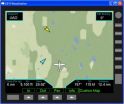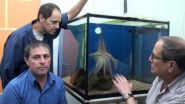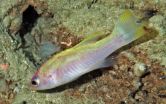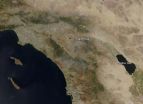(Press-News.org) A team from the Renewable Energy and Vehicular Technology Laboratory(REVT) at UT Dallas was one of a few research groups selected for advanced participation in a Department of Energy conference aimed at presenting the next generation of energy technologies.
The DOE's Advanced Research Projects Agency-Energy (ARPA-E) program hosts an annual summit in Washington, D.C., for researchers, entrepreneurs, investors, corporate executives and government officials to share transformational research funded through the program.
Dr. Babak Fahimi, professor of electrical engineering in the Erik Jonsson School of Engineering and Computer Scienceand director of REVT, has received $2.8 million through an ARPA-E programaimed at reducing rare earth metals, which are used in motors of electric vehicles. The metals are expensive, difficult to find and are usually imported into the United States from countries such as China. In addition, the mining process for these metals releases significant amounts of pollution into the atmosphere.
While hundreds of award recipients were invited to exhibit their research, Fahimi's team was one of five selected to demonstrate their work to lawmakers and participate in a round-table discussion on climate change.
REVT members demonstrated electric motors or generators that eliminate rare earth metals. Typical motors are powered through the electromagnetic interaction between a rotor, which contains rare earth metals and rotates, and another part known as a stator, which is stationary but houses electromagnetic sources. The REVT solution, called a double-stator switched reluctance machine (DSSRM), has two stators, one on either side of the rotor, that cause an electromagnetic reaction that produces power. This approach produces significantly greater power and torque at a given size and weight than traditional motor technologies without the use of permanent magnets.
"The transformative nature of our motor technology stems from a novel magnetic configuration, which significantly reduces the radial forces while increasing the motional forces by a factor of three," Fahimi said. "This technology also benefits from high levels of fault tolerance, low-cost manufacturing and low acoustic noise. I strongly believe this technology is highly appealing to automotive, oil and gas, and renewable energy industries."
Besides delivering more power and torque than competing technologies, this machine could be manufactured entirely in the United States, which would eliminate the pollution from mining rare earth metals, while also significantly reducing the amount of air pollution released through electric vehicle emissions. Other applications of this technology are airplanes, fans, pumps, wind generators and robots.
The research, first funded in 2012, has one patent pending. At the conference earlier this year, REVT members demonstrated the technology to potential commercial licensees.
Team members who demonstrated the technology included Pete Poorman, assistant director of corporate relations, and Drs. Wei Wang and Chenjie Lin, postdoctoral researchers in the lab.
"Having the opportunity to present at the ARPA-E Energy Innovation Summit was a huge opportunity to further our work," Poorman said. "Being one of the few projects selected for the round-table discussion and congressional reception is both an honor and an acknowledgement of the excellent work being done in the REVT lab."
INFORMATION: END
UT Dallas lab eliminates rare metals in electric motors
Lab members show work at DOE conference
2014-05-19
ELSE PRESS RELEASES FROM THIS DATE:
Genes play key role in brain injury risk for premature babies
2014-05-19
Premature babies' risk of brain injury is influenced by their genes, a new study suggests.
Researchers have identified a link between injury to the developing brain and common variation in genes associated with schizophrenia and the metabolism of fat.
The study builds on previous research, which has shown that being born prematurely – before 37 weeks – is a leading cause of learning and behavioural difficulties in childhood.
Around half of infants weighing less than 1500g at birth go on to experience difficulties in learning and attention at school age.
Scientists ...
Engineers find way to lower risk of midair collisions for small aircraft
2014-05-19
Researchers at North Carolina State University have developed new modifications for technology that helps pilots of small aircraft avoid midair collisions. The modified tools significantly improved pilot response times in making decisions to avert crashes.
At issue are "cockpit displays of traffic information" (CDTIs). These are GPS displays used by private pilots to track other aircraft in their vicinity. However, pilots often focus on the closest aircraft on the display – a habit that can pose a significant hazard.
If the pilot of Plane A sees two planes on the CDTI, ...
How octopuses don't tie themselves in knots revealed by Hebrew University scientists
2014-05-19
An octopus's arms are covered in hundreds of suckers that will stick to just about anything, with one important exception: those suckers generally won't grab onto the octopus itself, otherwise the impressively flexible animals would quickly find themselves all tangled up.
Now, researchers from the Hebrew University of Jerusalem report that they discovered how octopuses manage this feat, even as the creatures' brains are unaware of what their arms are doing. A chemical produced by octopus skin temporarily prevents their suckers from sucking.
"We were surprised that ...
The spot-tail golden bass: A new fish species from deep reefs of the southern Caribbean
2014-05-19
Smithsonian scientists describe a colorful new species of small coral reef sea bass from depths of 182–241 m off Curaçao, southern Caribbean. With predominantly yellow body and fins, the new species, Liopropoma santi, closely resembles the other two "golden basses" found together with it at Curaçao: L. aberrans and L. olneyi.
The scientists originally thought there was a single species of golden bass on deep reefs off Curaçao, but DNA data, distinct color patterns, and morphology revealed three. The study describing one of those, L. santi—the deepest known species of ...
Neutron beams reveal how antibodies cluster in solution
2014-05-19
Scientists have used small-angle neutron scattering (SANS) and neutron spin-echo (NSE) techniques for the first time to understand how monoclonal antibodies (mAbs), a class of targeted biopharmaceuticals used to treat autoimmune disorders and cancer, dynamically cluster and move in high concentration solutions. Certain mAb cluster arrangements can thicken pharmaceutical solutions; they could thus limit the feasible concentration of injectables administered to patients around the world. The insights provided by a team of neutron scientists from the National Center of Neutron ...
San Diego county fires still rage
2014-05-19
The San Diego County fires that began on Wednesday May 14 as a single fire that erupted into nine fires that burned out of control for days. According to News Channel 8, the ABC affiliate in San Diego, the following summarizes what the current conditions are for the fires still left burning:
"Cocos Fire - San Marcos: This fire has burned 1,995 acres and is 87 percent contained Monday morning. All evacuation orders and road closures were lifted as of 11 a.m. Sunday, according to the City of San Marcos.
San Mateo Fire - Camp Pendleton: The San Mateo Fire that was reported ...
New technique to prevent anal sphincter lesions due to episiotomy during child delivery
2014-05-19
Results of a 10-year long multinational research project on Technologies for Anal Sphincter analysis and Incontinence (TASI) are available in:
Corrado Cescon, Diego Riva , Vita Začesta, Kristina Drusany-Starič, Konstantinos Martsidis,
Olexander Protsepko, Kaven Baessler, Roberto Merletti
Effect of vaginal delivery on the external anal sphincter muscle innervation pattern evaluated by multichannel surface EMG: results of the multicentre study TASI-2
International Urogynecology Journal, DOI 10.1007/s00192-014-2375-0.
Episiotomy is a controversial surgical ...
Studies published in NEJM identify promising drug therapies for fatal lung disease
2014-05-19
LOS ANGELES (May 18, 2014) – Researchers in separate clinical trials found two drugs slow the progression of idiopathic pulmonary fibrosis, a fatal lung disease with no effective treatment or cure, and for which there is currently no therapy approved by the Food and Drug Administration.
Paul W. Noble, MD, chair of the Department of Medicine at Cedars-Sinai and director of the Women's Guild Lung Institute, is the senior author of the multicenter study that found that the investigational drug pirfenidone significantly slowed the loss of lung function and reduced the ...
EPA ToxCast data validates BioMAP® systems' ability to predict drug, chemical toxicities
2014-05-19
FREMONT, CA (May 19, 2014): Newly published research demonstrates the ability of BioMAP® Systems, a unique set of primary human cell and co-culture assays that model human disease and pathway biology, to identify important safety aspects of drugs and chemicals more efficiently and accurately than can be achieved by animal testing. Data from BioMAP Systems analysis of 776 environmental chemicals, including reference pharmaceuticals and failed drugs, on their ability to disrupt physiologically important human biological pathways were published online this week in Nature ...
Fluoridating water does not lower IQ: New Zealand research
2014-05-19
New research out of New Zealand's world-renowned Dunedin Multidisciplinary Study does not support claims that fluoridating water adversely affects children's mental development and adult IQ.
The researchers were testing the contentious claim that exposure to levels of fluoride used in community water fluoridation is toxic to the developing brain and can cause IQ deficits. Their findings are newly published in the highly respected American Journal of Public Health.
The Dunedin Study has followed nearly all aspects of the health and development of around 1000 people born ...
LAST 30 PRESS RELEASES:
Study: Teens use cellphones for an hour a day at school
After more than two years of war, Palestinian children are hungry, denied education and “like the living dead”
The untold story of life with Prader-Willi syndrome - according to the siblings who live it
How the parasite that ‘gave up sex’ found more hosts – and why its victory won’t last
When is it time to jump? The boiling frog problem of AI use in physics education
Twitter data reveals partisan divide in understanding why pollen season's getting worse
AI is quick but risky for updating old software
Revolutionizing biosecurity: new multi-omics framework to transform invasive species management
From ancient herb to modern medicine: new review unveils the multi-targeted healing potential of Borago officinalis
Building a global scientific community: Biological Diversity Journal announces dual recruitment of Editorial Board and Youth Editorial Board members
Microbes that break down antibiotics help protect ecosystems under drug pollution
Smart biochar that remembers pollutants offers a new way to clean water and recycle biomass
Rice genes matter more than domestication in shaping plant microbiomes
Ticking time bomb: Some farmers report as many as 70 tick encounters over a 6-month period
Turning garden and crop waste into plastics
Scientists discover ‘platypus galaxies’ in the early universe
Seeing thyroid cancer in a new light: when AI meets label-free imaging in the operating room
Neutrophil-to-lymphocyte ratio may aid risk stratification in depressive disorder
2026 Seismological Society of America Annual Meeting
AI-powered ECG analysis offers promising path for early detection of chronic obstructive pulmonary disease, says Mount Sinai researchers
GIMM uncovers flaws in lab-grown heart cells and paves the way for improved treatments
Cracking the evolutionary code of sleep
Medications could help the aging brain cope with surgery, memory impairment
Back pain linked to worse sleep years later in men over 65, according to study
CDC urges ‘shared decision-making’ on some childhood vaccines; many unclear about what that means
New research finds that an ‘equal treatment’ approach to economic opportunity advertising can backfire
Researchers create shape-shifting, self-navigating microparticles
Science army mobilizes to map US soil microbiome
Researchers develop new tools to turn grain crops into biosensors
Do supervised consumption sites bring increased crime? Study suggests that’s a myth
[Press-News.org] UT Dallas lab eliminates rare metals in electric motorsLab members show work at DOE conference



